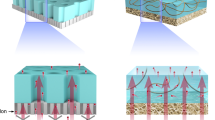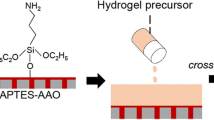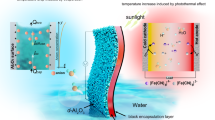Abstract
Coupling low-grade heat (LGH) with salinity gradient is an effective approach to increase the efficiency of the nanofluidic-membrane-based power generator. However, it is a challenge to fabricate membranes with high charge density that ensures ion permselectivity, while maintaining chemical and mechanical stability in this composite environment. Here, we develop a bis[2-(methacryloyloxy)ethyl] phosphate (BMAP) hydrogel membrane with good thermal stability and anti-swelling property through self-crosslinking of the selected monomer. By taking advantage of negative space charge and three-dimensional (3D) interconnected nanochannels, salinity gradient energy conversion efficiency is substantially enhanced by temperature difference. Theoretical and experimental results verify that LGH can largely weaken the concentration polarization, promoting transmembrane ion transport. As a result, such a hydrogel membrane delivers high-performance energy conversion with a power density of 11.53 W·m−2 under a negative temperature difference (NTD), showing a 193% increase compared with that without NTD.

Similar content being viewed by others
References
Jarvis, A. J.; Leedal, D. T.; Hewitt, C. N. Climate-society feedbacks and the avoidance of dangerous climate change. Nat. Climate Change 2012, 2, 668–671.
Chu, S.; Majumdar, A. Opportunities and challenges for a sustainable energy future. Nature 2012, 488, 294–303.
Logan, B. E.; Elimelech, M. Membrane-based processes for sustainable power generation using water. Nature 2012, 488, 313–319.
Siria, A.; Bocquet, M. L.; Bocquet, L. New avenues for the large-scale harvesting of blue energy. Nat. Rev. Chem. 2017, 1, 0091.
Pattle, R. E. Production of electric power by mixing fresh and salt water in the hydroelectric pile. Nature 1954, 174, 660.
Yang, J. L.; Tu, B.; Zhang, G. J.; Liu, P. C.; Hu, K.; Wang, J. R.; Yan, Z.; Huang, Z. W.; Fang, M. N.; Hou, J. J. et al. Advancing osmotic power generation by covalent organic framework monolayer. Nat. Nanotechnol. 2022, 17, 622–628.
Hao, J. R.; Bao, B.; Zhou, J. J.; Cui, Y. S.; Chen, X. C.; Zhou, J. L.; Zhou, Y. H.; Jiang, L. A euryhaline-fish-inspired salinity self-adaptive nanofluidic diode leads to high-performance blue energy harvesters. Adv. Mater. 2022, 34, 2203109.
Zhang, Z.; Bhauriyal, P.; Sahabudeen, H.; Wang, Z. Y.; Liu, X. H.; Hambsch, M.; Mannsfeld, S. C. B.; Dong, R. H.; Heine, T.; Feng, X. L. Cation-selective two-dimensional polyimine membranes for highperformance osmotic energy conversion. Nat. Commun. 2022, 13, 3935.
Chen, C.; Liu, D.; He, L.; Qin, S.; Wang, J. M.; Razal, J. M.; Kotov, N. A.; Lei, W. W. Bio-inspired nanocomposite membranes for osmotic energy harvesting. Joule 2020, 4, 247–261.
Man, Z. M.; Safaei, J.; Zhang, Z.; Wang, Y. Z.; Zhou, D.; Li, P.; Zhang, X. G.; Jiang, L.; Wang, G. X. Serosa-mimetic nanoarchitecture membranes for highly efficient osmotic energy generation. J. Am. Chem. Soc. 2021, 143, 16206–16216.
Bian, G. S.; Pan, N.; Luan, Z. H.; Sui, X.; Fan, W. X.; Xia, Y. Z.; Sui, K. Y.; Jiang, L. Anti-swelling gradient polyelectrolyte hydrogel membranes as high-performance osmotic energy generators. Angew. Chem., Int. Ed. 2021, 60, 20294–20300.
Zhou, S. Y.; Hu, Y. H.; Xin, W. W.; Fu, L.; Lin, X. B.; Yang, L. S.; Hou, S. H.; Kong, X. Y.; Jiang, L.; Wen, L. P. Surfactant-assisted sulfonated covalent organic nanosheets: Extrinsic charge for improved ion transport and salinity-gradient energy harvesting. Adv. Mater. 2023, 35, 2208640.
Gray, G. T.; McCutcheon, J. R.; Elimelech, M. Internal concentration polarization in forward osmosis: Role of membrane orientation. Desalination 2006, 197, 1–8.
Cao, L. X.; Xiao, F. L.; Feng, Y. P.; Zhu, W. W.; Geng, W. X.; Yang, J. L.; Zhang, X. P.; Li, N.; Guo, W.; Jiang, L. Anomalous channel-length dependence in nanofluidic osmotic energy conversion. Adv. Funct. Mater. 2017, 27, 1604302.
Lin, T. W.; Hsu, J. P. Pressure-driven energy conversion of conical nanochannels: Anomalous dependence of power generated and efficiency on pH. J. Colloid Interface Sci. 2020, 564, 491–498.
Zhu, C. J.; Zuo, X. H.; Xian, W. P.; Guo, Q.; Meng, Q. W.; Wang, S.; Ma, S. Q.; Sun, Q. Integration of thermoelectric conversion with reverse electrodialysis for mitigating ion concentration polarization and achieving enhanced output power density. ACS Energy Lett. 2022, 7, 2937–2943.
de Kok, J. M.; de Valk, C.; van Kester, J. H. T. M.; de Goede, E.; Uittenbogaard, R. E. Salinity and temperature stratification in the Rhine Plume. Estuar. Coast. Shelf Sci. 2001, 53, 467–475.
Gingerich, D. B.; Mauter, M. S. Quantity, quality, and availability of waste heat from united states thermal power generation. Environ. Sci. Technol. 2015, 49, 8297–8306.
Lindley, D. The energy should always work twice. Nature 2009, 458, 138–141.
Bao, B.; Hao, J. R.; Bian, X. J.; Zhu, X. B.; Xiao, K.; Liao, J. W.; Zhou, J. J.; Zhou, Y. Z.; Jiang, L. 3D porous hydrogel/conducting polymer heterogeneous membranes with electro-/pH-modulated ionic rectification. Adv. Mater. 2017, 29, 1702926.
Zhao, Y. M.; Yan, Y. G.; Cui, X.; Wu, X. W.; Wang, H.; Huang, J.; Qiu, X. Y. A conductive, self-healing hybrid hydrogel with excellent water-retention and thermal stability by introducing ethylene glycol as a crystallization inhibitor. Colloids Surf. A Physicochem. Eng. Asp. 2020, 607, 125443.
Guo, Y. H.; Zhao, F.; Zhou, X. Y.; Chen, Z. C.; Yu, G. H. Tailoring nanoscale surface topography of hydrogel for efficient solar vapor generation. Nano Lett. 2019, 19, 2530–2536.
Lei, W. W.; Qi, S. H.; Rong, Q. F.; Huang, J.; Xu, Y. C.; Fang, R. C.; Liu, K. S.; Jiang, L.; Liu, M. J. Diffusion-freezing-induced microphase separation for constructing large-area multiscale structures on hydrogel surfaces. Adv. Mater. 2019, 31, 1808217.
Shi, Y.; Zhang, J.; Pan, L. J.; Shi, Y.; Yu, G. H. Energy gels: A bio-inspired material platform for advanced energy applications. Nano Today 2016, 11, 738–762.
Zhao, F.; Shi, Y.; Pan, L. J.; Yu, G. H. Multifunctional nanostructured conductive polymer gels: Synthesis, properties, and applications. Acc. Chem. Res. 2017, 50, 1734–1743.
Shi, Y.; Yu, G. H. Designing hierarchically nanostructured conductive polymer gels for electrochemical energy storage and conversion. Chem. Mater. 2016, 28, 2466–2477.
Kim, D. K.; Duan, C. H.; Chen, Y. F.; Majumdar, A. Power generation from concentration gradient by reverse electrodialysis in ion-selective nanochannels. Microfluid. Nanofluid. 2010, 9, 1215–1224.
Xiao, K.; Giusto, P.; Wen, L. P.; Jiang, L.; Antonietti, M. Nanofluidic ion transport and energy conversion through ultrathin free-standing polymeric carbon nitride membranes. Angew. Chem., Int. Ed. 2018, 57, 10123–10126.
Schoch, R. B.; Han, J.; Renaud, P. Transport phenomena in nanofluidics. Rev. Mod. Phys. 2008, 80, 839–883.
Rollings, R. C.; Kuan, A. T.; Golovchenko, J. A. Ion selectivity of graphene nanopores. Nat. Commun. 2016, 7, 11408.
Ding, L.; Xiao, D.; Lu, Z.; Deng, J. J.; Wei, Y. Y.; Caro, J.; Wang, H. H. Oppositely charged Ti3C2T MXene membranes with 2D nanofluidic channels for osmotic energy harvesting. Angew. Chem., Int. Ed. 2020, 59, 8720–8726.
Vermaas, D. A.; Veerman, J.; Saakes, M.; Nijmeijer, K. Influence of multivalent ions on renewable energy generation in reverse electrodialysis. Energy Environ. Sci. 2014, 7, 1434–1445.
Zhang, Z.; Yang, S.; Zhang, P. P.; Zhang, J.; Chen, G. B.; Feng, X. L. Mechanically strong MXene/Kevlar nanofiber composite membranes as high-performance nanofluidic osmotic power generators. Nat. Commun. 2019, 10, 2920.
Xin, W. W.; Xiao, H. Y.; Kong, X. Y.; Chen, J. J.; Yang, L. S.; Niu, B.; Qian, Y. C.; Teng, Y. F.; Jiang, L.; Wen, L. P. Biomimetic nacrelike silk-crosslinked membranes for osmotic energy harvesting. ACS Nano 2020, 14, 9701–9710.
Xin, W. W.; Zhang, Z.; Huang, X. D.; Hu, Y. H.; Zhou, T.; Zhu, C. C.; Kong, X. Y.; Jiang, L.; Wen, L. P. High-performance silk-based hybrid membranes employed for osmotic energy conversion. Nat. Commun. 2019, 10, 3876.
Gao, J.; Guo, W.; Feng, D.; Wang, H. T.; Zhao, D. Y.; Jiang, L. Highperformance ionic diode membrane for salinity gradient power generation. J. Am. Chem. Soc. 2014, 136, 12265–12272.
Zhou, S.; Xie, L.; Zhang, L. P.; Wen, L. P.; Tang, J. Y.; Zeng, J.; Liu, T. Y.; Peng, D. N.; Yan, M.; Qiu, B. L. et al. Interfacial super-assembly of ordered mesoporous silica-alumina heterostructure membranes with pH-sensitive properties for osmotic energy harvesting. ACSAppl. Mater. Interfaces 2021, 13, 8782–8793.
Zhang, Z.; Sui, X.; Li, P.; Xie, G. H.; Kong, X. Y.; Xiao, K.; Gao, L. C.; Wen, L. P.; Jiang, L. Ultrathin and ion-selective Janus membranes for high-performance osmotic energy conversion. J. Am. Chem. Soc. 2017, 139, 8905–8914.
Huang, X. D.; Zhang, Z.; Kong, X. Y.; Sun, Y.; Zhu, C. C.; Liu, P.; Pang, J. H.; Jiang, L.; Wen, L. P. Engineered PES/SPES nanochannel membrane for salinity gradient power generation. Nano Energy 2019, 59, 354–362.
Zhu, X. B.; Hao, J. R.; Bao, B.; Zhou, Y. H.; Zhang, H. B.; Pang, J. H.; Jiang, Z. H.; Jiang, L. Unique ion rectification in hypersaline environment: A high-performance and sustainable power generator system. Sci. Adv. 2018, 4, eaau1665.
Liu, Y. C.; Yeh, L. H.; Zheng, M. J.; Wu, K. C. W. Highly selective and high-performance osmotic power generators in subnanochannel membranes enabled by metal-organic frameworks. Sci. Adv. 2021, 7, eabe9924.
Li, R. R.; Jiang, J. Q.; Liu, Q. Q.; Xie, Z. Q.; Zhai, J. Hybrid nanochannel membrane based on polymer/MOF for highperformance salinity gradient power generation. Nano Energy 2018, 53, 643–649.
Chen, W. P.; Zhang, Q. R.; Qian, Y. C.; Xin, W. W.; Hao, D. Z.; Zhao, X. L.; Zhu, C. C.; Kong, X. Y.; Lu, B. Z.; Jiang, L. et al. Improved ion transport in hydrogel-based nanofluidics for osmotic energy conversion. ACS Cent. Sci. 2020, 6, 2097–2104.
Chen, W. P.; Wang, Q.; Chen, J. J.; Zhang, Q. R.; Zhao, X. L.; Qian, Y. C.; Zhu, C. C.; Yang, L. S.; Zhao, Y. Y.; Kong, X. Y. et al. Improved ion transport and high energy conversion through hydrogel membrane with 3D interconnected nanopores. Nano Lett. 2020, 20, 5705–5713.
Zhang, Z.; He, L.; Zhu, C. C.; Qian, Y. C.; Wen, L. P.; Jiang, L. Improved osmotic energy conversion in heterogeneous membrane boosted by three-dimensional hydrogel interface. Nat. Commun. 2020, 11, 875.
Zhang, W. Y.; Yan, H. L.; Wang, Q. W.; Zhao, C. L. An extended Teorell-Meyer-Sievers theory for membrane potential under non-isothermal conditions. J. Membr. Sci. 2022, 643, 120073.
Long, R.; Kuang, Z. F.; Liu, Z. C.; Liu, W. Ionic thermal up-diffusion in nanofluidic salinity-gradient energy harvesting. Natl. Sci. Rev. 2019, 6, 1266–1273.
Tseng, S.; Li, Y. M.; Lin, C. Y.; Hsu, J. P. Salinity gradient power: Influences of temperature and nanopore size. Nanoscale 2016, 8, 2350–2357.
Mai, V. P.; Huang, W. H.; Yang, R. J. Enhancing ion transport through nanopores in membranes for salinity gradient power generation. ACS EST Eng. 2021, 1, 1725–1752.
Chen, K. X.; Yao, L. N.; Su, B. Bionic thermoelectric response with nanochannels. J. Am. Chem. Soc. 2019, 141, 8608–8615.
Zhang, P. C.; Chen, S. F.; Zhu, C. J.; Hou, L. X.; Xian, W. P.; Zuo, X. H.; Zhang, Q. H.; Zhang, L.; Ma, S. Q.; Sun, Q. Covalent organic framework nanofluidic membrane as a platform for highly sensitive bionic thermosensation. Nat. Commun. 2021, 12, 1844.
Wu, Y. D.; Zhou, T.; Wang, Y.; Qian, Y. X.; Chen, W. P.; Zhu, C. C.; Niu, B.; Kong, X. Y.; Zhao, Y. F.; Lin, X. B. et al. The synergistic effect of space and surface charge on nanoconfined ion transport and nanofluidic energy harvesting. Nano Energy 2022, 92, 106709.
Hwang, J.; Sekimoto, T.; Hsu, W. L.; Kataoka, S.; Endo, A.; Daiguji, H. Thermal dependence of nanofluidic energy conversion by reverse electrodialysis. Nanoscale 2017, 9, 12068–12076.
Mai, V. P.; Yang, R. J. Boosting power generation from salinity gradient on high-density nanoporous membrane using thermal effect. Appl. Energy 2020, 274, 115294.
Zhu, H. Y.; Qu, Z. G.; Wang, Q.; Zhang, J. F. Dimension unification and dominance evaluation of multi-physical parameters for nanochannel-based ionic thermoelectric energy conversion using similarity principle. Energy Convers. Manage., 2023, 276, 116589.
Ren, Q. L.; Chen, K. L.; Zhu, H. Y.; Zhang, J. F.; Qu, Z. G. Nanoparticle enhanced salinity-gradient osmotic energy conversion under photothermal effect. Energy Convers. Manage., 2022, 251, 115032.
Acknowledgements
This work was supported by the National Key R&D Program of China (Nos. 2022YFB3805904, 2022YFB3805900, and 2020YFA0710401), the National Natural Science Foundation of China (Nos. 22122207, 21988102, and 52075138), CAS Key Laboratory of Bio-inspired Materials and Interfacial Science, Technical Institute of Physics and Chemistry (No. BMIS202102), China Postdoctoral Science Foundation (Nos. 2022TQ0345, 2022M723229, and 2022M713226), and Postdoctoral International Exchange Talent-Introducing Program (No. YJ20220199).
Author information
Authors and Affiliations
Corresponding authors
Electronic Supplementary Material
12274_2023_5794_MOESM1_ESM.pdf
Temperature difference-enhanced salinity gradient energy conversion enabled by thermostable hydrogel membrane with anti-swelling property
Rights and permissions
About this article
Cite this article
Zhang, Z., Zhou, T., Kong, XY. et al. Temperature difference-enhanced salinity gradient energy conversion enabled by thermostable hydrogel membrane with anti-swelling property. Nano Res. 16, 11288–11295 (2023). https://doi.org/10.1007/s12274-023-5794-8
Received:
Revised:
Accepted:
Published:
Issue Date:
DOI: https://doi.org/10.1007/s12274-023-5794-8




